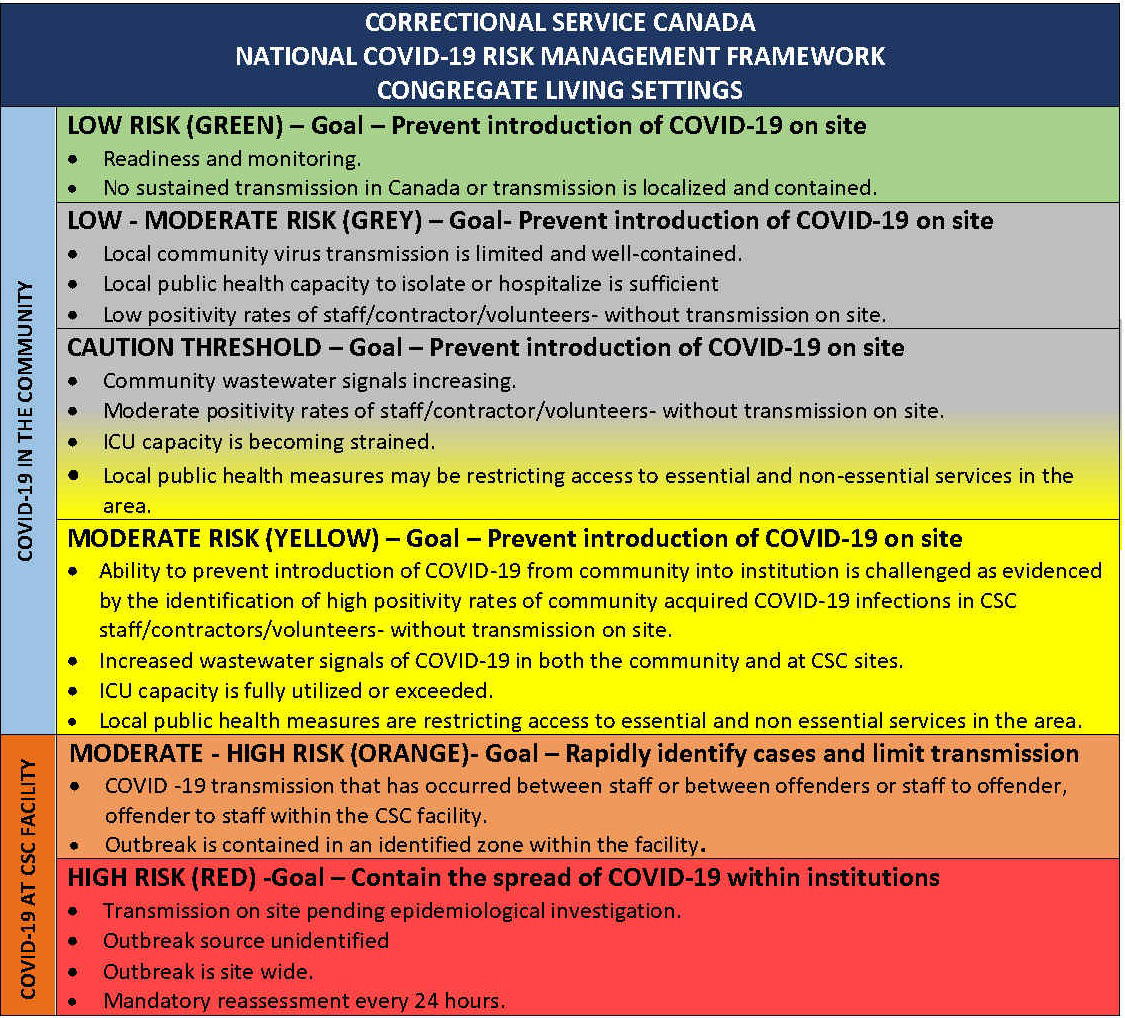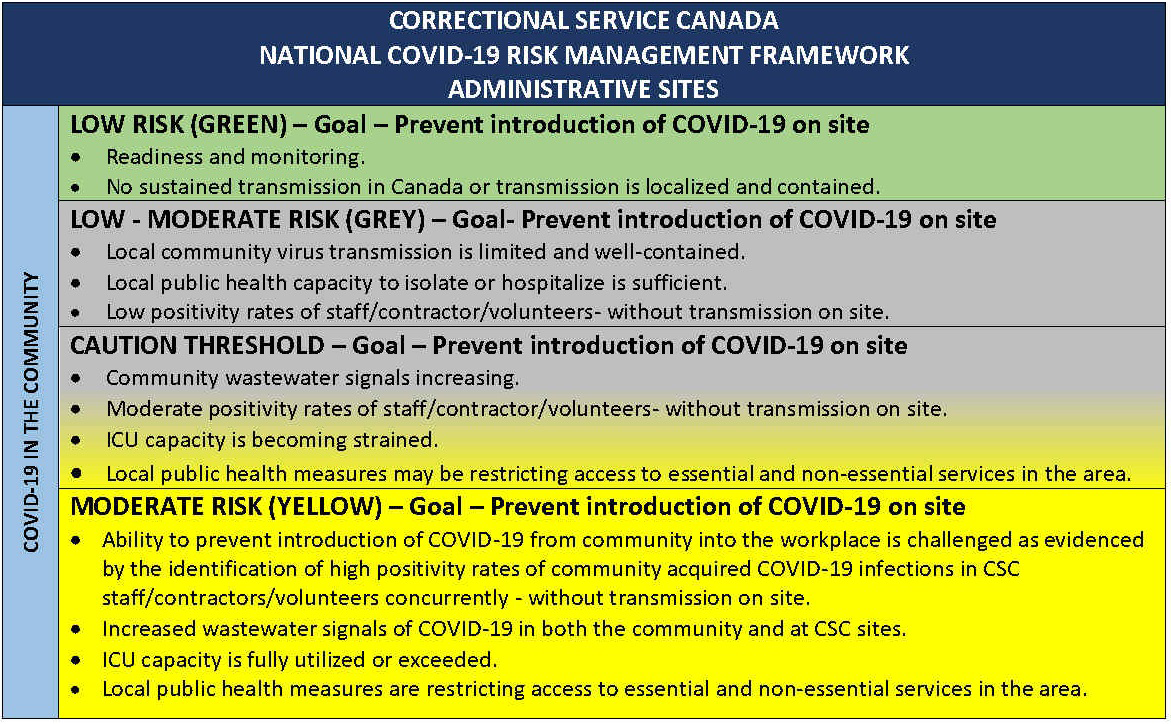COVID-19 in federal corrections: Framework for managing risk
This page has been archived
Information identified as archived is provided for reference, research or recordkeeping purposes only. It is not subject to the Government of Canada Web Standards and has not been altered or updated since it was archived.
Integrated Risk Management Framework
CSC established an Integrated Risk Management Framework (IRMF) to guide our sites to carefully resume services, programs, and interventions for offenders, while keeping everyone safe. The IRMF was developed in collaboration with public health authorities, labour partners, and stakeholders to establish the mitigation strategies for each activity. It is reviewed and updated regularly so that CSC is ready to adapt its operations quickly, as required.
The framework identifies correctional activities and mitigation strategies to protect CSC staff and offenders, while respecting the law and delivering on CSC’s legislated mandate. It also allows for different levels of response depending on the assessed level of risk of COVID-19 transmission in a community, based on public health information.
Risk Levels
The IRMF clearly outlines how we conduct business under five possible risk levels for our institutions and Community Correctional Centres.
Under each of the five risk levels, CSC identifies correctional activities and mitigation strategies to protect staff, offenders and the public.
Congregate living settings
The following chart outlines the risk levels for CSC’s congregate living settings:

CSC National COVID-19 Risk Management Framework: Congregate living setting
COVID-19 in the community:
Low risk (green), goal: prevent introduction of COVID-19 on site- readiness and monitoring
- no sustained transmission in Canada or transmission is localized and contained
- local community virus transmission is limited and well-contained
- local public health capacity to isolate or hospitalize is sufficient
- low positivity rates of staff/contractor/volunteers, without transmission on site
- community wastewater signals increasing
- moderate positivity rates of staff/contractor/volunteers, without transmission on site
- intensive care unit (ICU) capacity is becoming strained
- local public health measures may be restricting access to essential and non-essential services in the area
- ability to prevent introduction of COVID-19 from community into institution is challenged as evidenced by the identification of high positivity rates of community acquired COVID-19 infections in CSC staff/contractors/volunteers- without transmission on site
- increased wastewater signals of COVID-19 in both the community and at CSC sites
- intensive care unit (ICU) capacity is fully utilized or exceeded
- local public health measures are restricting access to essential and non essential services in the area
Moderate-high risk (orange), goal: rapidly identify cases and limit transmission
- COVID -19 transmission that has occurred within the CSC facility:
- between staff
- between offenders
- staff to offender, or
- offender to staff
- outbreak is contained in an identified zone within the facility
- transmission on site pending epidemiological investigation
- outbreak source unidentified
- outbreak is site wide
- mandatory reassessment every 24 hours
Administrative sites
The following chart outlines the risk levels for CSC’s administrative sites (Regional and National Headquarters, Correctional Learning and Development Centres, Academies, District and Parole Offices):

CSC National COVID-19 Risk Management Framework: Congregate living setting
COVID-19 in the community:
Low risk (green), goal: prevent introduction of COVID-19 on site- readiness and monitoring
- no sustained transmission in Canada or transmission is localized and contained
- local community virus transmission is limited and well-contained
- local public health capacity to isolate or hospitalize is sufficient
- low positivity rates of staff/contractor/volunteers, without transmission on site
- community wastewater signals increasing
- moderate positivity rates of staff/contractor/volunteers, without transmission on site
- intensive care unit (ICU) capacity is becoming strained
- local public health measures may be restricting access to essential and non-essential services in the area
- ability to prevent introduction of COVID-19 from community into the workplace is challenged as evidenced by the identification of high positivity rates of community acquired COVID-19 infections in CSC staff/contractors/volunteers, without transmission on site
- increased wastewater signals of COVID-19 in both the community and at CSC sites
- intensive care unit (ICU) capacity is fully utilized or exceeded
- local public health measures are restricting access to essential and non essential services in the area
Activities in the IRMF
The following activities are included in the IRMF. New activities may be added on a regular basis as the relevant risk mitigation strategies are developed.
Congregate living settings
Institutional operations:
- Admissions and discharge
- Operations
- Inmate work
- Recreation
- Barbers, hairstylists and nail technicians
- Regional dieticians
- Visits and correspondence
- Volunteers
- Restorative Opportunities Program
- Temporary absences, work releases and transfers by land
- Temporary absences and transfers by air
Health services:
- Foundational measures
- Primary care
- Secondary care
- Tertiary care
- Assessments
- Risk assessments
Reintegration operations:
- Institutional parole officers and managers of assessment and intervention
- Correctional programs, structured social programs
- Educational programs
- Institutional employment program and vocational certification
- Indigenous initiatives
- Chaplaincy services
- Parole Board of Canada hearings
- Elder-assisted hearings
- Mother Child Program
Community Operations:
- Community correctional centres
- Community-based residential facilities
- Urinalysis program
Internal Services:
- Construction
Administrative sites
Internal Services:
- Training
- Essential training: all staff
- Operational training
- Specialized training: operational
- Specialized training: nursing
- Specialized training: organizational
- Management development
- Detector Dog Program
- National Training Academy
- Primary worker candidate assessments
- Indigenous community liaison officers and Indigenous community development officers
- Community correctional programs
- Urinalysis program
- Employment coordinator: community
- CORCAN community industries
- Volunteers
- Restorative Opportunities Program
- Parole Board of Canada hearings
- Community health services
Page details
- Date modified: